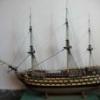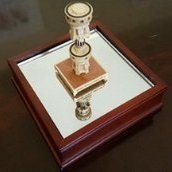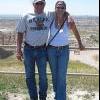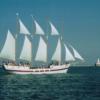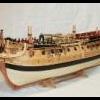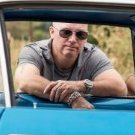Supplies of the Ship Modeler's Handbook are running out. Get your copy NOW before they are gone! Click on photo to order.
×
-
Posts
4,873 -
Joined
-
Last visited
Reputation Activity
-
 gjdale reacted to Mirabell61 in SS Kaiser Wilhelm der Grosse 1897 by Mirabell61 - FINISHED - scale 1:144 - POF - first German four stacker of the Norddeutscher Lloyd line
gjdale reacted to Mirabell61 in SS Kaiser Wilhelm der Grosse 1897 by Mirabell61 - FINISHED - scale 1:144 - POF - first German four stacker of the Norddeutscher Lloyd line
Update...
stuctures on the boats deck, and always considering the deck curvature over the width
Nils
-
 gjdale got a reaction from Nirvana in USF Confederacy by Augie & Moonbug - FINISHED - Model Shipways - 1:64
gjdale got a reaction from Nirvana in USF Confederacy by Augie & Moonbug - FINISHED - Model Shipways - 1:64
Nice to see you back at it Bug.
-
 gjdale reacted to tlevine in HMS Atalanta 1775 by tlevine - FINISHED - 1:48 scale - from TFFM plans
gjdale reacted to tlevine in HMS Atalanta 1775 by tlevine - FINISHED - 1:48 scale - from TFFM plans
Time for a bit of an update. The quarter deck framing is completed. There are several openings in the midline which need to be addressed. Most forward is the ladderway, followed by the upper capstan step. Behind that are three gratings panels. Each of the gratings is designed to be different in width, so they needed to be made individually, rather than making a long strip of grating and simply cutting off the length required.
This leaves a final opening in front of the mizzen mast. On the deck plan there is a dotted line within the outline of the hatch, suggesting that the was a structure inserted into the opening. The openings for the grating do not have the same dotted line; therefore the structure was not a grating. David states that it is possible there was a companion over this opening. On the plan view there is no structure visible above the hatch coaming. Below this opening is the salon...officer's country. I doubt they would have wanted to get wet or, even more so, have their conversations overheard. So a companion will be made for the opening.
Finally, there is a scuttle for the topmast tackle in front of and lateral to the ladderway opening.
-
 gjdale reacted to ggrieco in Heroine 1838 by ggrieco - FINISHED - Scale 1:24 - Western River Steamboat as she appeared before hitting a snag in the Red River
gjdale reacted to ggrieco in Heroine 1838 by ggrieco - FINISHED - Scale 1:24 - Western River Steamboat as she appeared before hitting a snag in the Red River
Hello everybody,
I was was starting to feel a little burnt out trying to catch up with model two so I had to take a little break for the Holidays. I was able to get the tarred roof on and the chimneys completed but, never got a chance to post. Sorry for leaving many steps out trying to catch up.
For the tarred roof I used silk. I experimented with several adhesives but finally settled on shellac. One very thin application to penetrate the wood. Then a second heavier coat to provide a layer to bond to. I was a little concerned that I would never be able to get the wrinkles out but, after laying the silk on the roof and brushing with shellac, the silk pulled itself to the prepared surface like a magnet. I was able to apply the entire roof in about 30 minutes. The shellac dries to an almost glass hard surface and bonds quite well.
Test piece wood with silk applied. The silk was originally blue but, somehow changed to dark black the moment the shellac made contact. I have no idea about the physics of it but it saved me from having to paint the entire surface.
Completed tarred roof on the model.
Ground glazing installed on the skylights.
To make the chimneys as rigid as possible, I used an oak dowel as a core.
wooden rings were used as spacers between the top ends of the chimney segments and the dowels. The lower edge of the segment fit tightly over the segment just below it.
The chimneys required three guy wires each for support. We had plenty of illustrations but only a couple showed the location of all three. Information was combined from several illustrations.
The Ouachita
Delphine
Homer
Napoleon
Yellow Stone
Selma
Bands for the guy wires.
[
Blackened bands
Guy wires in place.
Machined pieces of the pawl rims.
Completed pawl rims waiting for their pawls.
-
 gjdale reacted to cog in IJN Yamato by RGL - FINISHED - Tamiya - 1/350 - PLASTIC
gjdale reacted to cog in IJN Yamato by RGL - FINISHED - Tamiya - 1/350 - PLASTIC
Robin,
You haven't seen the surface of our dining table. Now I mention it, neither have I for a long time
(Sorry for hijacking your log Greg, couldn't resist ... )
-
 gjdale reacted to dafi in HMS Victory by dafi - Heller - PLASTIC - To Victory and beyond ...
gjdale reacted to dafi in HMS Victory by dafi - Heller - PLASTIC - To Victory and beyond ...
So I went on to search for different kind of papers and found something from the restoration department :-) Immediately had to try this out - and I never have been that near to what was being encapsulated in my strange brainsalads ... ... the back side was without any crisps ... ... and the transparency was perfect too ... ... and if I still manage to fit the doubling on the front and back sides to to match ... ... and I further on renounce to put two strips of "canvas" atop each other - as to be seen in strip n#6 -... ... yep, then ... ... ...hihihihihihihihi... That is why I immediately did the next test piece. And got the appearence even closer to my aim. The doubling is made a layer thicker as it consists in reality of 4 layers of cloth, not just two. Also I added some copper thread in the seam, even though it will possibly be a bit difficult in a larger sail. Then painted with some diluted wall paper glue dyed very carefully with a mixture of 3 parts light grey and one part yellow ochre :-) Here some shots of the nice play with light, changing appearance from frontal, side and back light Slowly we go :-) ... slowly ...
XXXDAn -
 gjdale got a reaction from hamilton in 1949 Chris-Craft 19' Racing Runabout by gjdale - FINISHED -Dumas - 1:8 Scale - RADIO
gjdale got a reaction from hamilton in 1949 Chris-Craft 19' Racing Runabout by gjdale - FINISHED -Dumas - 1:8 Scale - RADIO
Thanks again folks for all the kind comments and the "likes" - they really encourage me to keep striving.
A fairly major update today as I've completed manufacturing all the parts for the new steering wheel.
Wheel Building continued - the Hubs
If I thought that the hard part was over …..
The first step was to actually design my hub components. Although Kip had very kindly sent me a copy of his “chook scratchings” from the design process, I needed to make a couple of design changes to suit my slightly different approach (primarily the fact that the steering shaft will thread into the rear hub). I had several exchanges of email with Kip throughout this process and that was a huge help in getting my head around the task. Here is a copy of my own early chook scratchings.
From here, I decided to make up a set of CAD drawings of each component to further understand what I was attempting to do, and also as a useful check on my own measurements and calculations. Needless to say, there were many changes to both this diagram and the CAD drawings as the manufacturing process got underway – “no plan, no matter how good, survives first contact with the enemy!”
Once I had the design principles clearly in my head, the manufacturing process actually went quite smoothly…….for the most part. In fact, it went so well that I forgot to take many progress shots. In the next picture, I am drilling the banjo spoke holes into what will become the banjo spoke hub. This started as a piece of 5/8” brass rod, that was first bored to leave a wall thickness of 1.5 mm. The banjo spoke holes are all 0.5 mm in diameter and I managed to drill all twelve without breaking the drill bit. Ironically, the drill bit broke just as I was removing it from the mill.
The manufacturing process required some thought as to how to hold various pieces on the lathe while they were being turned and shaped and fitted to their final dimensions. After a bit of trial and error, I concluded that several mandrels of various key sizes, both solid and centre-bored, were the most useful thing to use. I found that gluing these temporarily with CA to the stock being machined held the piece securely while being worked. The parts were then separated by the judicious application of heat from the MAPP blow torch. Here is a shot of the various mandrels I used – in some cases a combination of two mandrels were required.
The rear hub was shaped by first cutting a series of steps (staircase effect) and then smoothing with a round file while still on the lathe. The Horn Ring Hub, Trim Piece and Cap piece required a radius on the end. The Radius Cutting attachment for the lathe worked a treat for these parts.
The Horn Ring itself is square in section and this was formed by using a 1/16” square brass tube. After first annealing with the MAPP torch, it was bent around the same wooden buck as used for the wheel rim. The buck was first turned down to the appropriate diameter, and I must confess here to having a couple of goes at this before I was satisfied with the size. As the tube is hollow, it allowed me to insert a piece of 0.8 mm brass rod inside and extending across the join. This really helped when silver-soldering the join closed. The piece was then returned to the rotary table on the mill and 0.85 mm holes were drilled at 120 degree intervals for mounting the spokes.
The spokes for the horn ring are also square in section and the same brass tube was used for this. By inserting a piece of the 0.8mm brass rod through the pre-drilled hole in the horn ring, right through the length of the spoke, and into the horn ring hub, the hole assembly becomes self-aligning.
The horn ring hub itself was probably the most difficult of all of these parts to make and I had three attempts at this before I was finally satisfied.
The Cap Piece, as well as having a radius turned on the end, also had a 1/32” slot cut with a slitting saw to receive the Throttle Lever, which itself was cut and filed from a piece of 1/32” brass flat bar.
The picture below shows all of these parts, starting with the Wheel Rim and a selection of banjo spokes at the rear, the Horn Ring, Horn Ring Hub and Horn Ring Spokes (temporarily mounted and ready for soldering), and then across the front from left to right are the Rear Hub (note the internal threading to receive the steering column), the Banjo Spoke Hub, the Trim Piece, and the Cap Piece, with the Throttle Lever in the foreground.
Putting some of these components together for the camera, here is a of shot of the Horn Ring assembly mounted on the Banjo Spoke Hub, mounted on the Rear Hub, with a temporary Steering Shaft.
And lastly, the same assembly with the stainless-steel sleeve that goes over the steering shaft.
That completes the manufacture of all components for the new steering wheel. The next job will be to solder the Horn Ring assembly together, and then chrome plate the Horn Ring assembly, Cap Piece and Throttle Lever. The other components will be painted an off-white (ivory) colour, and then the whole lot will be finally assembled.
Once that is done, I will return attention to making the cutwater….
-
 gjdale got a reaction from popeye the sailor in Santa Maria by Moonbug - FINISHED - Artesania Latina - Bashed
gjdale got a reaction from popeye the sailor in Santa Maria by Moonbug - FINISHED - Artesania Latina - Bashed
Congratulations Bug - well deserved!
-
 gjdale got a reaction from Shazmira in 1949 Chris-Craft 19' Racing Runabout by gjdale - FINISHED -Dumas - 1:8 Scale - RADIO
gjdale got a reaction from Shazmira in 1949 Chris-Craft 19' Racing Runabout by gjdale - FINISHED -Dumas - 1:8 Scale - RADIO
Thanks again folks for all the kind comments and the "likes" - they really encourage me to keep striving.
A fairly major update today as I've completed manufacturing all the parts for the new steering wheel.
Wheel Building continued - the Hubs
If I thought that the hard part was over …..
The first step was to actually design my hub components. Although Kip had very kindly sent me a copy of his “chook scratchings” from the design process, I needed to make a couple of design changes to suit my slightly different approach (primarily the fact that the steering shaft will thread into the rear hub). I had several exchanges of email with Kip throughout this process and that was a huge help in getting my head around the task. Here is a copy of my own early chook scratchings.
From here, I decided to make up a set of CAD drawings of each component to further understand what I was attempting to do, and also as a useful check on my own measurements and calculations. Needless to say, there were many changes to both this diagram and the CAD drawings as the manufacturing process got underway – “no plan, no matter how good, survives first contact with the enemy!”
Once I had the design principles clearly in my head, the manufacturing process actually went quite smoothly…….for the most part. In fact, it went so well that I forgot to take many progress shots. In the next picture, I am drilling the banjo spoke holes into what will become the banjo spoke hub. This started as a piece of 5/8” brass rod, that was first bored to leave a wall thickness of 1.5 mm. The banjo spoke holes are all 0.5 mm in diameter and I managed to drill all twelve without breaking the drill bit. Ironically, the drill bit broke just as I was removing it from the mill.
The manufacturing process required some thought as to how to hold various pieces on the lathe while they were being turned and shaped and fitted to their final dimensions. After a bit of trial and error, I concluded that several mandrels of various key sizes, both solid and centre-bored, were the most useful thing to use. I found that gluing these temporarily with CA to the stock being machined held the piece securely while being worked. The parts were then separated by the judicious application of heat from the MAPP blow torch. Here is a shot of the various mandrels I used – in some cases a combination of two mandrels were required.
The rear hub was shaped by first cutting a series of steps (staircase effect) and then smoothing with a round file while still on the lathe. The Horn Ring Hub, Trim Piece and Cap piece required a radius on the end. The Radius Cutting attachment for the lathe worked a treat for these parts.
The Horn Ring itself is square in section and this was formed by using a 1/16” square brass tube. After first annealing with the MAPP torch, it was bent around the same wooden buck as used for the wheel rim. The buck was first turned down to the appropriate diameter, and I must confess here to having a couple of goes at this before I was satisfied with the size. As the tube is hollow, it allowed me to insert a piece of 0.8 mm brass rod inside and extending across the join. This really helped when silver-soldering the join closed. The piece was then returned to the rotary table on the mill and 0.85 mm holes were drilled at 120 degree intervals for mounting the spokes.
The spokes for the horn ring are also square in section and the same brass tube was used for this. By inserting a piece of the 0.8mm brass rod through the pre-drilled hole in the horn ring, right through the length of the spoke, and into the horn ring hub, the hole assembly becomes self-aligning.
The horn ring hub itself was probably the most difficult of all of these parts to make and I had three attempts at this before I was finally satisfied.
The Cap Piece, as well as having a radius turned on the end, also had a 1/32” slot cut with a slitting saw to receive the Throttle Lever, which itself was cut and filed from a piece of 1/32” brass flat bar.
The picture below shows all of these parts, starting with the Wheel Rim and a selection of banjo spokes at the rear, the Horn Ring, Horn Ring Hub and Horn Ring Spokes (temporarily mounted and ready for soldering), and then across the front from left to right are the Rear Hub (note the internal threading to receive the steering column), the Banjo Spoke Hub, the Trim Piece, and the Cap Piece, with the Throttle Lever in the foreground.
Putting some of these components together for the camera, here is a of shot of the Horn Ring assembly mounted on the Banjo Spoke Hub, mounted on the Rear Hub, with a temporary Steering Shaft.
And lastly, the same assembly with the stainless-steel sleeve that goes over the steering shaft.
That completes the manufacture of all components for the new steering wheel. The next job will be to solder the Horn Ring assembly together, and then chrome plate the Horn Ring assembly, Cap Piece and Throttle Lever. The other components will be painted an off-white (ivory) colour, and then the whole lot will be finally assembled.
Once that is done, I will return attention to making the cutwater….
-
 gjdale reacted to Geek1945 in DIY Pull Saw Miter Box
gjdale reacted to Geek1945 in DIY Pull Saw Miter Box
This is the neatest hobby size miter box located so far here's a link, you judge it:
http://woodarchivist.com/1469-diy-pull-saw-miter-box/
Other DIY tools/jigs are also available at WOODARCHIVIST site suggest you browse it.
Enjoy Ed
-
 gjdale reacted to cog in 1949 Chris-Craft 19' Racing Runabout by gjdale - FINISHED -Dumas - 1:8 Scale - RADIO
gjdale reacted to cog in 1949 Chris-Craft 19' Racing Runabout by gjdale - FINISHED -Dumas - 1:8 Scale - RADIO
That's a lovely job Grant. If ever I need to make a wheel, I'll know where to lookup the howto. Although, I wonder if I will ever get it half as good as yours ...
Cheers
-
 gjdale reacted to RGL in IJN Yamato by RGL - FINISHED - Tamiya - 1/350 - PLASTIC
gjdale reacted to RGL in IJN Yamato by RGL - FINISHED - Tamiya - 1/350 - PLASTIC
So, 27 more triple 25MM's.
The bases including the seats and windage levers.
Plonk the barrels on.
Finished and I'm just a bit over these things.
-
 gjdale reacted to Moonbug in USF Confederacy by Augie & Moonbug - FINISHED - Model Shipways - 1:64
gjdale reacted to Moonbug in USF Confederacy by Augie & Moonbug - FINISHED - Model Shipways - 1:64
Finished off the bow this weekend by adding the boomkins, associated rigging and blocks, and then the railing.
-
 gjdale reacted to Chuck in HM Cutter Cheerful 1806 by Chuck - FINISHED - 1:48 scale - kit prototype
gjdale reacted to Chuck in HM Cutter Cheerful 1806 by Chuck - FINISHED - 1:48 scale - kit prototype
I am about to make the two yards for Cheerful and the center of each is eight sided. So I am going to start with a square stick and then turn it into an Octagon. I will round off the ends and taper them afterwards. I am using the 7/10/7 template to mark the stick so I can create the eight sided shape.
When I was preparing my square stock I thought that everyone would probably benefit from the template I am using and created. It will save you time so you dont have to make one. Attached is a PDF template that is prepared with the correct ratios. I have been using it all along to make the masts and other spars. Its a very handy template to have.
seventenseven.pdf
Chuck
-
 gjdale got a reaction from GuntherMT in 1949 Chris-Craft 19' Racing Runabout by gjdale - FINISHED -Dumas - 1:8 Scale - RADIO
gjdale got a reaction from GuntherMT in 1949 Chris-Craft 19' Racing Runabout by gjdale - FINISHED -Dumas - 1:8 Scale - RADIO
Thanks again folks for all the kind comments and the "likes" - they really encourage me to keep striving.
A fairly major update today as I've completed manufacturing all the parts for the new steering wheel.
Wheel Building continued - the Hubs
If I thought that the hard part was over …..
The first step was to actually design my hub components. Although Kip had very kindly sent me a copy of his “chook scratchings” from the design process, I needed to make a couple of design changes to suit my slightly different approach (primarily the fact that the steering shaft will thread into the rear hub). I had several exchanges of email with Kip throughout this process and that was a huge help in getting my head around the task. Here is a copy of my own early chook scratchings.
From here, I decided to make up a set of CAD drawings of each component to further understand what I was attempting to do, and also as a useful check on my own measurements and calculations. Needless to say, there were many changes to both this diagram and the CAD drawings as the manufacturing process got underway – “no plan, no matter how good, survives first contact with the enemy!”
Once I had the design principles clearly in my head, the manufacturing process actually went quite smoothly…….for the most part. In fact, it went so well that I forgot to take many progress shots. In the next picture, I am drilling the banjo spoke holes into what will become the banjo spoke hub. This started as a piece of 5/8” brass rod, that was first bored to leave a wall thickness of 1.5 mm. The banjo spoke holes are all 0.5 mm in diameter and I managed to drill all twelve without breaking the drill bit. Ironically, the drill bit broke just as I was removing it from the mill.
The manufacturing process required some thought as to how to hold various pieces on the lathe while they were being turned and shaped and fitted to their final dimensions. After a bit of trial and error, I concluded that several mandrels of various key sizes, both solid and centre-bored, were the most useful thing to use. I found that gluing these temporarily with CA to the stock being machined held the piece securely while being worked. The parts were then separated by the judicious application of heat from the MAPP blow torch. Here is a shot of the various mandrels I used – in some cases a combination of two mandrels were required.
The rear hub was shaped by first cutting a series of steps (staircase effect) and then smoothing with a round file while still on the lathe. The Horn Ring Hub, Trim Piece and Cap piece required a radius on the end. The Radius Cutting attachment for the lathe worked a treat for these parts.
The Horn Ring itself is square in section and this was formed by using a 1/16” square brass tube. After first annealing with the MAPP torch, it was bent around the same wooden buck as used for the wheel rim. The buck was first turned down to the appropriate diameter, and I must confess here to having a couple of goes at this before I was satisfied with the size. As the tube is hollow, it allowed me to insert a piece of 0.8 mm brass rod inside and extending across the join. This really helped when silver-soldering the join closed. The piece was then returned to the rotary table on the mill and 0.85 mm holes were drilled at 120 degree intervals for mounting the spokes.
The spokes for the horn ring are also square in section and the same brass tube was used for this. By inserting a piece of the 0.8mm brass rod through the pre-drilled hole in the horn ring, right through the length of the spoke, and into the horn ring hub, the hole assembly becomes self-aligning.
The horn ring hub itself was probably the most difficult of all of these parts to make and I had three attempts at this before I was finally satisfied.
The Cap Piece, as well as having a radius turned on the end, also had a 1/32” slot cut with a slitting saw to receive the Throttle Lever, which itself was cut and filed from a piece of 1/32” brass flat bar.
The picture below shows all of these parts, starting with the Wheel Rim and a selection of banjo spokes at the rear, the Horn Ring, Horn Ring Hub and Horn Ring Spokes (temporarily mounted and ready for soldering), and then across the front from left to right are the Rear Hub (note the internal threading to receive the steering column), the Banjo Spoke Hub, the Trim Piece, and the Cap Piece, with the Throttle Lever in the foreground.
Putting some of these components together for the camera, here is a of shot of the Horn Ring assembly mounted on the Banjo Spoke Hub, mounted on the Rear Hub, with a temporary Steering Shaft.
And lastly, the same assembly with the stainless-steel sleeve that goes over the steering shaft.
That completes the manufacture of all components for the new steering wheel. The next job will be to solder the Horn Ring assembly together, and then chrome plate the Horn Ring assembly, Cap Piece and Throttle Lever. The other components will be painted an off-white (ivory) colour, and then the whole lot will be finally assembled.
Once that is done, I will return attention to making the cutwater….
-
 gjdale reacted to Alex M in HMS Sphynx 1775 by Alex M - Scale 1/48 - English 20-Gun Frigate
gjdale reacted to Alex M in HMS Sphynx 1775 by Alex M - Scale 1/48 - English 20-Gun Frigate
Hello,
today only a small update, the work going slowly. The fore part of planking was most complicated one, I decide to make them as one piece of three plank to achieve clear rounding. The first image show the principle:
Here both pieces glued in place:
Overall view:
First plank of after part is also glued.
Alex
-
 gjdale got a reaction from Elijah in USF Confederacy by Augie & Moonbug - FINISHED - Model Shipways - 1:64
gjdale got a reaction from Elijah in USF Confederacy by Augie & Moonbug - FINISHED - Model Shipways - 1:64
Nice to see you back at it Bug.
-
 gjdale got a reaction from mtaylor in Granado by rafine - FINISHED - Caldercraft - 1:64
gjdale got a reaction from mtaylor in Granado by rafine - FINISHED - Caldercraft - 1:64
Nice work on the ratlines Bob. It may be tedious, but your experience shows!
-
 gjdale got a reaction from popeye the sailor in USF Confederacy by Augie & Moonbug - FINISHED - Model Shipways - 1:64
gjdale got a reaction from popeye the sailor in USF Confederacy by Augie & Moonbug - FINISHED - Model Shipways - 1:64
Nice to see you back at it Bug.
-
 gjdale got a reaction from mtaylor in Cutter Cheerful 1806 by Rustyj - FINISHED - 1:48 Scale
gjdale got a reaction from mtaylor in Cutter Cheerful 1806 by Rustyj - FINISHED - 1:48 Scale
Very nice Rusty.
-
 gjdale got a reaction from Rustyj in Cutter Cheerful 1806 by Rustyj - FINISHED - 1:48 Scale
gjdale got a reaction from Rustyj in Cutter Cheerful 1806 by Rustyj - FINISHED - 1:48 Scale
Very nice Rusty.
-
 gjdale got a reaction from Canute in Cutter Cheerful 1806 by Rustyj - FINISHED - 1:48 Scale
gjdale got a reaction from Canute in Cutter Cheerful 1806 by Rustyj - FINISHED - 1:48 Scale
Very nice Rusty.
-
 gjdale got a reaction from Canute in Granado by rafine - FINISHED - Caldercraft - 1:64
gjdale got a reaction from Canute in Granado by rafine - FINISHED - Caldercraft - 1:64
Nice work on the ratlines Bob. It may be tedious, but your experience shows!
-
 gjdale got a reaction from Moonbug in USF Confederacy by Augie & Moonbug - FINISHED - Model Shipways - 1:64
gjdale got a reaction from Moonbug in USF Confederacy by Augie & Moonbug - FINISHED - Model Shipways - 1:64
Nice to see you back at it Bug.
-
 gjdale reacted to RGL in IJN Yamato by RGL - FINISHED - Tamiya - 1/350 - PLASTIC
gjdale reacted to RGL in IJN Yamato by RGL - FINISHED - Tamiya - 1/350 - PLASTIC
After a few days off due to illness, the 25mm triple mass production continues.
For ease of application they are laid out on masking tape and the barrels added.
Then the magazines folded and placed in blue tack facing the right way for application.
Then the sights and rear handles added. Whilst the alignment is not perfect, they are soo tiny it is not really noticeable with the naked eye.


